PESTS AND DISEASES OF FORESTRY IN NEW ZEALAND
Bacterial leaf spot and canker of poplar, willow, and alder
Scion is the leading provider of forest-related knowledge in New Zealand
Formerly known as the Forest Research Institute, Scion has been a leader in research relating to forest health for over 50 years. The Rotorua-based Crown Research Institute continues to provide science that will protect all forests from damage caused by insect pests, pathogens and weeds. The information presented below arises from these research activities.
Forest Pathology in New Zealand No. 21,
Bacterial leaf spot and canker of poplar, willow, and alder.
Based on A.G. Spiers (1990)
Causal organism
Pseudomonas syringae pv. syringae van Hall
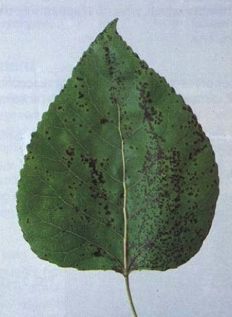
Fig. 1 - Leaf of a Populus deltoides x P. ciliata seedling exhibiting leaf spot incited by P. syringae pv. syringae.
Type of injury
Leaf spotting. Cankers on twigs, branches, and stems of mainly 1- to 2- year-old plants with associated dieback. Occasional whole-plant death where cankers form low on the stem.
Diagnostic features
- Yellow flecks (1-3 mm diam.) on upper and lower leaf surfaces.
- Dark brown spots of irregular outline on both leaf surfaces. Spots may remain discrete, or merge forming larger blotches.
- Terminal and side shoot dieback with blackened buds and collapsed, desiccated foliage.
- Rough fissures or sunken, blackened lesions on stems (cankers).
- Bacterial ooze from cankers which, when dry, appears as a white deposit on the stem.
Hosts
Populus spp. - All species present in Now Zealand are susceptible but leaf spotting is most prevalent on P. ciliata, P. deltoides, P. szechuanica, P. trichocarpa, P. yunnanensis, and their hybrids.
Salix spp. - All species present in New Zealand are susceptible. Stem and twig dieback is more common than leaf spotting.
Alnus cordata - Leaf spotting and twig dieback.
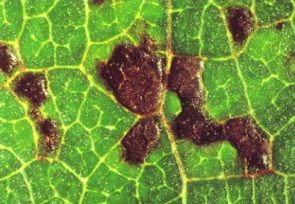
Fig. 2 - Collapsed necrotic tissue on a P. deltoides x ciliata leaf after infection by P. syringae pv. syringae.
Distribution
Throughout New Zealand, particularly in localities with high summer rainfall.
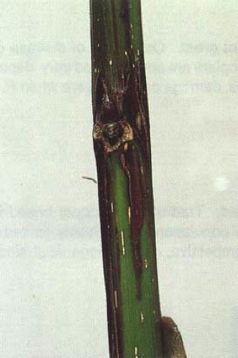
Fig. 3 - Year-old shoot of a P. deltoides x ciliata seedling exhibiting bud and stem necrosis after Infection by P. syringae pv. syringae .
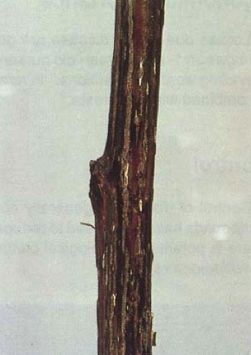
Fig. 4 - Year-old shoot of a P. deltoides x ciliata seedling exhibiting stem cankering as a result of earlier infection by P. syringae pv. syringae .
Disease development
Leaf symptoms first appear in spring when temperatures are rising and moisture levels are high. Throughout the growing season, during periods of continuous rainfall (>3 days), spots are produced on new leaves. For example, a severe attack of P. syringae occurred on foliage and stems of poplars growing in a nursery at Aokautere during a 4-month period (November 1985-February 1986), when rainfall was 64% (194 mm) more than average, and rain fell on 52 of those 120 days. Depending on the cultivar, spots may either remain discrete, or merge forming extensive blotches. In poplars leaf spotting is generally more common than stem cankering and is often seen on plants which do not exhibit any other symptoms.
Formation of stem and twig cankers also depends on high moisture levels. Symptoms vary - stems may be roughly fissured or have sunken black lesions oozing bacteria. Sometimes the whole stem is affected, killing the plant; more often only the top one third to one half of the plant, or only lateral branches, are involved. When there is extensive shoot and twig dieback with blackened dead foliage the condition is referred to as "blast'. New shoots grow from below the infected areas on stems and branches. Although stem fissures and cankers may heal and the plant continue to grow, this often leaves a weak point which makes the plant susceptible to breakage in high winds.
Some severe outbreaks of the disease occur when sudden frosts follow a warmer wet period. Approximately 50% of Pseudomonas syringae isolates, tested from poplars and willows in New Zealand were capable of causing ice-nucleation. Ice-nucleating bacteria initiate the formation of ice crystals within host cells during frosts, and the combination of bacteria and frost causes more extensive tissue disruption than if either factor were present independently.
Economic importance
Losses due to this disease are generally not great. Outbreaks of disease due to P. syringae on 1- and 2-year-old nursery grown poplars are sporadic and very dependent on prevailing weather conditions. In rare instances, damage can be severe when P. syringae is combined with late frosts.
Control
Control of disease is generally not warranted. Traditionally, copper-based inorganic compounds have been used to reduce bacterial populations but with only limited success. There is potential for biological control with competitive, non-pathogenic strains of other Pseudomonas species.
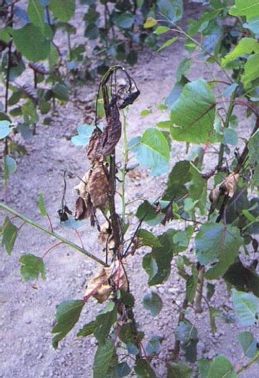
Fig. 5 - Terminal and side shoot dieback of a P. deltoides cultivar exhibiting the classical symptoms of "blast" after infection by P. syringae pv. syringae .
Bibliography
Haworth, R.H.; Spiers, A.G. 1988: Characterisation of bacteria from poplars and willows exhibiting leaf spotting and stem cankering in New Zealand. European Journal of Forest Pathology 18: 426-436.
Kam, M. de 1982: Damage to poplar caused by Pseudomonas syringae in combination with frost and fluctuating temperatures. European Journal of Forest Pathology 12: 203-209.
Compiled 1990: revised 2010
This information is intended for general interest only. It is not intended to be a substitute for specific specialist advice on any matter and should not be relied on for that purpose. Scion will not be liable for any direct, indirect, incidental, special, consequential or exemplary damages, loss of profits, or any other intangible losses that result from using the information provided on this site.
(Scion is the trading name of the New Zealand Forest Research Institute Limited.)

 Farm Forestry New Zealand
Farm Forestry New Zealand

